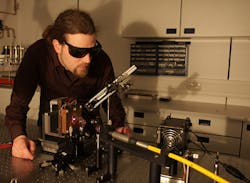Disk laser from Marburg/Tucson cooperation achieves record 100 W output
Marburg, Germany and Tucson, AZ--Researchers from Philipps-Universität Marburg and the College of Optical Sciences at the University of Arizona have developed the first semiconductor disk laser to emit light with an output power of more than 100 W, strongly enhancing the laser application potential for materials processing and other functions. The breakthrough is published in Electronics Letters (B.Heinen et al., Electronics Letters 48, 516 (2012)). The performance record was achieved jointly by the Marburg groups led by professors Wolfgang Stolz, Martin Koch, and Stephan Koch and Tucson College of Optical Sciences and the company Nonlinear Control Strategies (Tucson, AZ).
The previous record set in 2010 was 40 W; since then, the researchers says that several laboratories have been working towards a 100 W disk laser result; namely, Coherent (Santa Clara, CA) reported a fundamental power of 60 W at 1064 nm at SPIE Photonics West in January 2012, and the Marburg/Tucson team previously pushed the performance to around 70 W but at a heatsink temperature of -15°C. The current results break the 100 W barrier at even moderate heatsink temperatures of 3°C.
This milestone was reached as the result of many careful design and optimization steps both on the theoretical and on the experimental side, said graduate student Bernd Heinen, who has done most of the experimental laboratory work at Philipps Universität in Marburg.
To achieve the record performance, it was crucial to avoid the thermal rollover which arises due to two distinct physical mechanisms in the vertical external-cavity surface-emitting laser (VECSEL): (1) As the active resonant periodic gain (RPG) multiple quantum well section of the chip heats up, the gain peak shifts more rapidly to longer wavelength than the microcavity resonance of the RPG. The key is to design the VECSEL chip such that the gain peak is at a shorter wavelength than the microcavity resonance at room temperature such that both coincide at the maximum operational temperature of the active region. Once the gain peak shifts beyond the microcavity resonance, the device rapidly shuts off; (2) Another fundamental physical mechanism promoting thermal rollover is a runaway increase in Auger losses at high temperatures. These are often considered to be a major player at longer wavelengths but they also play a crucial role at the high internal operation temperatures in short wavelength devices.
Improved thermal management is essential. The Tucson/Marburg team used a mounting technique that involves bonding an upside-down grown VECSEL chip (the top DBR region) to a CVD diamond heat spreader. The gallium arsenide (GaAs) substrate is completely removed via a chemical etch. Although in this configuration the heat has to flow down through the DBR, the heat spreading and sinking is more efficient.
The strength of the consortium is the seamless integration of sophisticated microscopic quantum design of optimized resonant periodic gain structures coupled with unsurpassed growth accuracy of the full resonant periodic gain on a Bragg mirror. The wafer growth methodology delivers fully qualified wafers where the growth accuracy can be immediately validated at wafer level via high resolved X-ray diffraction in line with surface photoluminescence and reflection spectra guaranteeing unsurpassed performance of the operational device.
The researchers say that these disk-based VECSELs provide the first clearly defined pathway to developing multi- and potentially, kilowatt-class high-brightness, high-power semiconductor lasers. Their wavelength flexibility through epitaxial design offers unsurpassed performance at targeted wavelengths and, moreover, the high intra-cavity powers that can approach kilowatt levels lead to efficient generation of high-power high brightness visible and UV sources through intra-cavity second and fourth harmonic generation.
SOURCE: Philipps-Universität Marburg;www.uni-marburg.de
IMAGE: Bernd Heinen works on a semiconductor disk laser jointly developed by Marburg, Germany and Tucson, AZ researchers that achieved a record 100 W output. (Courtesy Philipps-Universität Marburg)
